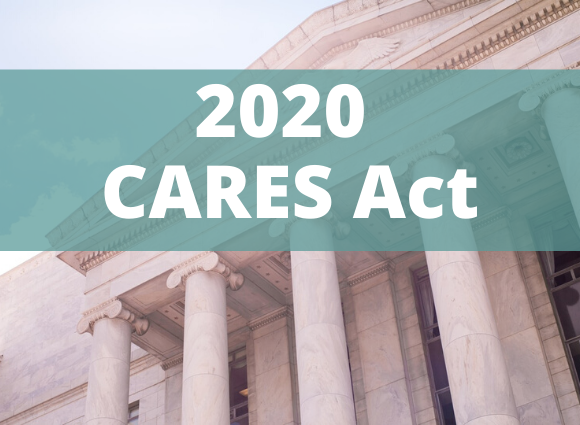
Major Business Assistance Provisions of the 2020 CARES Act
On March 27th, President Trump signed into law the 2020 CARES Act, which provides several provisions that are extremely relevant to small and mid-sized businesses. Two of the most significant provisions – 1) the Paycheck Protection loan program and related forgiveness provisions and 2) the Employee Retention payroll tax credit and 2020 payroll tax deferral – are mutually exclusive, meaning you can’t qualify for both but must choose one avenue or the other.
Option 1: Paycheck Protection Program
One program that you may have heard about is the Paycheck Protection Program that gives businesses with fewer than 500 employees — including sole proprietors and nonprofits— the opportunity to apply for SBA guaranteed loans. These loans are meant to cover many of the operating costs of these businesses while the effect of COVID-19 is most severe. The loans will have a maximum maturity of 10 years, an interest rate not to exceed 4% and there is no personal guarantee required by the business owner. For those in the restaurant industry, there is a special provision that allows the 500 employee count determination to be made at each physical location versus for the overall employer company.
The loans are generally limited to the LESSER OF:
$10 million OR the sum of 1) Average monthly “payroll costs” for the one-year period ending on the date the loan was made (an alternative calculation is available for seasonal employers) multiplied by 2.5; and 2) Any disaster loan (discussed below) taken out after January 31, 2020, that has been refinanced into a paycheck protection loan. So, 2 ½ months of payroll costs, plus the amount of any refinanced disaster loan, but not to exceed $10 million.
For purposes of this calculation, payroll costs are the sum of the following:
- Wages, commissions, salary, or similar compensation to an employee or independent contractor,
- Allowance for dismissal or separation,
- Cash tips or equivalent,
- Vacation, parental, family, medical or sick leave,
- Or payment for group health care benefits, including premiums,
- Payment of any retirement benefits, and
- Payment of state or local tax assessed on the compensation of employees,
Payroll costs do not include, however:
- Compensation of any individual employee in excess of an annual salary of $100,000,
- Federal payroll taxes
- Compensation of an employee whose principal place of residence is outside the U.S
- An employee with qualified sick leave or family medical leave for which a credit is allowed under the new Coronavirus Relief Act passed last week.
Here is an example:
Example. John’s restaurant applies for a paycheck protection loan on May 1, 2020. John’s business has $12 million in payroll costs for the period May 1, 2019, through May 1, 2020, for a monthly average of $1,000,000. He is entitled to a fully guaranteed federal loan —assuming it’s made before December 31, 2020 — equal to the lesser of $2,500,000 ($1,000,000 in average payroll costs * 2.5) or $10 million.
Loan Forgiveness of Paycheck Protection Loans
A portion of the aforementioned Paycheck Protection loans may be forgiven on a tax-free basis. The amount to be forgiven is the sum of the following payments made by the borrower during the 8-week period beginning on the date of the loan:
- Payroll costs (as defined above)
- Mortgage interest,
- Rent
- Certain utility payments.
In order to seek loan forgiveness, the borrower must submit to the lender an application that includes documentation verifying the number of employees and pay rates, and canceled checks showing mortgage, rent, or utility payments. Here is an example using John’s restaurant:
There are reductions in the amount of forgiveness, however, if an employer reduces the number of employees in the 8-week covered period compared to the number the employer had in either the period from February 15, 2019, to June 30, 2019, or compared to the period from January 1, 2020, to February 29, 2020. In addition, there are reductions if the employer reduces wages for employees who make less than $100,000 per year by more than 25% compared to the last full quarter before the covered period.
Continuing the previous example with John’s Restaurant: In the first 8 weeks after the business borrows the $2,500,000, the restaurant pays $2,000,000 in payroll costs, mortgage interest, and utility payments. The restaurant has the same number of employees in that 8-week period that it had during the applicable 2019 timeframe. John’s Restaurant is eligible to have $2,000,000 of the $2,500,000 loan forgiven. The forgiveness will not create taxable income. In addition, because of the deferment rules in the CARES Act, any payments due on the remaining $500,000 will not be due for six months.
Same example, but John’s Restaurant had already cut its total staff in half compared to the applicable historical timeframes. The total loan forgiven would be reduced to $1,000,000.
Option 2: Payroll Tax Credits and Deferral
Employee Retention Credit
The Employee Retention Credit provides a refundable credit against the employer-side social security tax for 50 percent of wages paid by employers to employees in certain circumstances. Specifically, the credit is available against wages paid to employees for any employer who experiences a full or partial shutdown as a result of COVID-19 or has gross receipts decline by more than 50 percent when compared to the same time period of the previous year. If you have more than 100 full-time equivalent employees, qualified wages are wages paid to employees when they are not providing services because they are absent due to COVID-19. If you have fewer than 100 full-time equivalent employees, all employees qualify for the credit, whether the business is open or subject to shut down, but only until gross receipts go back to 80% of the level experienced in the prior year. The credit applies to a maximum of $10,000 of compensation for each employee which includes health benefits paid to an employee. The time period is for wages paid or incurred from March 13 through December 31, 2020.
Delay of Payment of Employer Payroll Tax and Self-Employment Tax
In addition to the potential employee retention credit, the new law also helps to alleviate the burden on employers by allowing the employer’s share of the 6.2% Social Security tax that would otherwise be due from the date of enactment through December 31, 2020, to be paid on December 31, 2021 (50%) and December 31, 2022 (50%).
A self-employed taxpayer can defer paying 50% of his or her self-employment tax that would be due from the date of enactment through the end of 2020 until the end of 2021 (25%) and 2022 (25%).
What this means is that an employer who incurs 6.2% share of Social Security tax in 2020 can defer payment of that tax until 2021 and 2020, but can also receive an immediate credit against those yet-to-be paid payroll taxes via the sum of the emergency medical leave credit, sick leave credit, and new employee retention credit.
There is no clear answer as to whether Option 1 or Option 2 is right for a general business. Discuss these options with your accounting and tax advisor to determine which option is best for you and your business.
This content was created during a snapshot in time and should be relied upon as such. Legislation and guidance continue to change as we progress through the current fluid environment and the information may not be applicable at a later date. All content and materials are for general information purposes only. If you have questions regarding your specific situation, please contact us.




